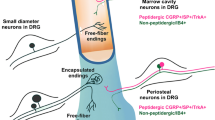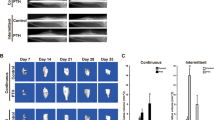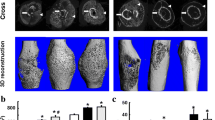Abstract
We investigated the effect of eel calcitonin (elcatonin) on the process of fracture repair in the osteotomized femur of cynomolgus monkeys, since they possess a Haversian remodeling system similar to that of humans. Alendronate was used for comparison. Twenty female cynomolgus monkeys (Macaca fascicularis), aged 18–22 years, were allocated into five groups: control (CNT, n = 4), low-dose elcatonin group (0.5 U/kg; ELL, n = 4), high-dose elcatonin group (5 U/kg; ELH, n = 4), low-dose alendronate group (10 μg/kg; ALL, n = 4) and high-dose alendronate group (100 μg/kg; ALH, n = 4). All animals were given subcutaneous injections twice a week for 3 weeks. Then fracture was produced surgically by transversely cutting the midshaft of the right femur and fixing with stainless steel plate. After fracture, treatments were continued until sacrifice at 26 weeks after surgery. The femora were assessed by micro CT, contact microradiograph, three-point bending mechanical test and histomorphometry. Micro CT showed that callus sizes in elcatonin-treated groups were similar to CNT, whereas alendronate-treated groups had larger calluses than those in the CNT and elcatonin-treated groups. Fracture lines almost disappeared in the CNT and elcatonin-treated groups but remained clear in the alendronate-treated groups. Total area did not differ significantly between the elcatonin-treated groups and the CNT but was significantly greater in the ALH compared to the CNT and elcatonin-treated groups, due to increased callus area in the ALH group. Callus remodeling was less suppressed in the elcatonin-treated groups than in the alendronate-treated groups when compared with callus remodeling in the CNT. Although no significant differences in structural mechanical properties such as ultimate load, stiffness and work to failure were found among all groups, ultimate stress was significantly reduced in the ALH group compared with CNT and ELL groups. In conclusion, mild suppression of callus remodeling by elcatonin did not impair overall fracture healing process. In contrast, alendronate delayed structural fracture healing process by strongly suppressing callus remodeling.



Similar content being viewed by others
References
Rodan GA, Fleisch HA (1996) Bisphosphonates: mechanisms of action. J Clin Invest 97:2692–2696
Russell RG, Rogers MJ (1999) Bisphosphonates: from the laboratory to the clinic and back again. Bone 25:97–106
Delmas PD (2002) Different effects of antiresorptive therapies on vertebral and nonvertebral fractures in postmenopausal osteoporosis. Bone 30:14–17
Delmas PD (2002) Treatment of postmenopausal osteoporosis. Lancet 359:2018–2026
Fleisch H (2001) Can bisphosphonates be given to patients with fractures? J Bone Miner Res 16:437–440
Rodan GA, Martin TJ (2000) Therapeutic approaches to bone diseases. Science 289:1508–1514
Fujita T, Fujii Y, Miyauchi A, Takagi Y (1999) Comparison of antiresoptive activities of ipriflavone, an isoflavone derivative, and elcatonin, an eel carbocalcitonin. J Bone Miner Metab 17:289–295
Hori M, Takahashi H, Konno T, Inoue J, Haba T, Sakurada T, Noda T, Fujimoto K (1984) Effect of elcatonin on experimental osteoporosis induced by ovariectomy and low calcium diet in beagles. Nippon Yakurigaku Zasshi 84:91–98
Yoshikawa S, Shiba M, Hoshino T, Igarashi M, Orimo H, Sakuma A, Tsuyama N (1983) Effect of eel calcitonin derivative(elcatonin) in osteoporosis. Nippon Seikeigeka Gakkai Zasshi 57:1717–1728
Sato M, Rippy MK, Bryant HU (1996) Raloxifene, tamoxifen, nafoxidine, or estrogen effects on reproductive and nonreproductive tissue in ovariecyomized rat. FASEB J 10:905–912
Chavassieux PM, Arlot ME, Reda C, Wei L, Yates AJ, Meunier PJ (1997) Histomorphometric assessment of the long-term effects of alendronate on bone quality and remodeling in patients with osteoporosis. J Clin Invest 100:1475–1480
Li J, Mori S, Kaji Y, Mashiba T, Kawanishi J, Norimatsu H (1999) Effect of bisphosphonate (incadronate) on fracture healing of long bones in rats. J Bone Miner Res 14:969–979
Li J, Mori S, Kaji Y, Kawanishi J, Akiyama T, Norimatsu H (2000) Concentration of bisphosphonate (incadronate) in callus area and its effects on fracture healing in rats. J Bone Miner Res 15:2042–2051
Li C, Mori S, Li J, Kaji Y, Akiyama T, Kawanishi J, Norimatsu H (2001) Long-term effect of incadronate disodium (YM-175) on fracture healing of femoral shaft in growing rats. J Bone Miner Res 16:429–436
Cao Y, Mori S, Mashiba T, Westmore MS, Ma L, Sato M, Akiyama T, Shi L, Komatsubara S, Miyamoto K, Norimatsu H (2002) Raloxifene, estrogen, and alendronate affect the processes of fracture repair differently in ovariectomized rats. J Bone Miner Res 17:2237–2246
Cao Y, Mori S, Mashiba T, Kaji Y, Manabe T, Iwata K, Miyamoto Kensaku, Komatsubara S, Yamamoto T (2007) 1α-25-Dihydroxy-2β(3-hydroxypropoxy)vitamin D3 (ED-71) suppressed callus remodeling but did not interfere with fracture healing in rat femora. Bone 40:132–139
Chambers TJ, Moore A (1983) The sensitivity of isolated osteoclasts to morphological transformation by calcitonin. J Clin Endocrinol Metab 57:819–824
Knopp JA, Diner BM, Blitz M (2005) Calcitonin for treating acute pain of osteoporotic vertebral compression fractures: a systematic review of randomized, controlled trials. Osteoporos Int 16:1281–1290
Ishida Y, Kawai S (2004) Comparative efficacy of hormone replacement therapy, etidronate calcitonin, alfacalcidol, and vitamin K in postmenopausal women with osteoporosis: Yamagata Osteoporosis Prevention Study. Am J Med 117:549–555
Fujita T, Fujii Y, Goto B (1997) A three-year comparative trial in osteoporosis treatment: effect of combined alfacalcidol and elcatonin. J Bone Miner Metab 15:223–226
Orimo H, Morii H, Inoue T (1996) Effect of elcatonin on involutional osteoporosis. J Bone Miner Metab 14:73–78
Aro HT, Wippermann BW, Hodgson SF, Chao EY (1990) Internal remodeling of periosteal new bone during fracture healing. J Orthop Res 8:238–246
Schenk RK, Hunziker EB (1994) Histologic and ultrastructural features of fracture healing. In: Brington CT, Friedlaender GE, Lane JM (eds) Bone regeneration and repair, 1st edn. American Academy of Orthopedic Surgeons, Rosemont, IL, USA, pp 117–146
Einhorn TA (1998) The cell and molecular biology of fracture healing. Clin Orthop 355S:S7–S21
Frost HM (1998) The biology of fracture healing. Clin Orthop 248:283–309
McKibbin B (1978) The biology of fracture healing in long bones. J Bone Joint Surg Br 60-B:150–162
Ikegame M, Ejiri S, Ozawa H (1994) Histochemical and autoradiographic studies on elcatonin internalization and intracellular movement in osteoclasts. J Bone Miner Res 9:25–37
Meschia M, Brincat M, Barbacini P (1993) A clinical trial on effects of a combination of elcatonin (carbo-calcitonin) and conjugated estrogens on vertebral bone mass in early postmenopausal women. Calcif Tissue Int 53:17–20
Nicholson GC, Moseley JM, Sexton PM, Mendelsohn FAO, Martin TJ (1986) Abundant calcitonin receptors in isolated rat osteoclasts. J Clin Invest 78:355–360
Suda T, Takahashi N, Martin TJ (1992) Modulation of Osteoclast differentiation. Endocr Rev 13:66–80
Lin HY, Harris TL, Flannery MS, Azuffo A, Kaji EH, Gorn A, Kolakowski LF Jr, Lodish HF, Goldring SR (1991) Expression cloning of an adenylate cyclase-coupled calcitonin receptor. Science 254:1022–1024
Nancollas GH, Tang R, Phipps RJ, Henneman Z, Gulde S, Wu W, Mangood A, Russell RGG, Ebetino FH (2006) Novel insights into actions of bisphonates on bone: Differences in interactions with hydroxyapatite. Bone 38:617–627
Acknowledgments
The authors thank Mika Kawada and Yoshiko Fukuda for histological preparation and Asahi Kasei Co. for kindly supplying the elcatonin.
Conflict of interest statement
All authors have no conflict of interest associated with this study and publication.
Author information
Authors and Affiliations
Corresponding author
About this article
Cite this article
Manabe, T., Mori, S., Mashiba, T. et al. Eel calcitonin (elcatonin) suppressed callus remodeling but did not interfere with fracture healing in the femoral fracture model of cynomolgus monkeys. J Bone Miner Metab 27, 295–302 (2009). https://doi.org/10.1007/s00774-009-0046-x
Received:
Accepted:
Published:
Issue Date:
DOI: https://doi.org/10.1007/s00774-009-0046-x




